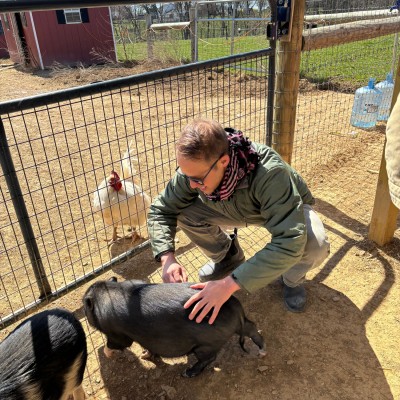Fury, Patience, and Animal Lovers
Back To Blogs


Fury, Patience, and Animal Lovers
10/31/2025
World Vegan Day is November 1, 2026. This year it reminds me of how I continue to live between two poles: fury and patience.
First, fury.
The systemic brutality that humans inflict upon animals is beyond abhorrent and demands the utmost urgency. The scale of their suffering defies comprehension. Vegan advocacy, and the broader struggle for animal liberation, could not be more pressing.
Second, patience.
“Meeting people where they are” is the only choice for animal advocates whether we like it or not. Human supremacism takes time to recognize and unlearn. We should remember that many of us—including seasoned advocates—still struggle to understand and see the evils of white supremacism, cisgender supremacism, ethnonationalism, and other forms of intra-human domination. If we need patience in confronting those injustices, how much more so in confronting the entrenched hierarchies between humans and other animals?
Many advocates (I was once one) find their patience uniquely tested when confronted with “animal lovers” who claim to love the animals they buy, sell, breed, eat, and sometimes even kill. The common response—“How can loving and killing coexist?”—rests on the assumption that love and wrongdoing are mutually exclusive. But are they? After all, most of us know that those who love us can still wrong us, and it is often because of that love that the wrong hurts so badly.
This apparent paradox brings to mind an episode from Radhika Govindrajan’s Animal Intimacies: Interspecies Relatedness in India’s Central Himalayas. Here Govindrajan explores how feelings of love—specifically maternal love—not only inform relations between humans and goats, but also complicate any evaluation of the ethicality of animal sacrifice due to the tension between normative principles and affective elements. According to locals, animal sacrifice is not a heartless mechanical transaction—offer a life and wait to receive what you request—but rather a complex process charged with emotion. Central to its efficacy is the sacrificer’s mamta—maternal love—for the animal. Neema, one of Govindrajan’s informants, recounts an old story: in earlier times, the devī (goddess) demanded blood sacrifice in the form of a human child. When the time came for an old widow to appease the devī, she could not bear the thought of surrendering her only child. The widow pleaded with the goddess, offering to substitute the human child with “animals that she had raised just like her own children.” The devī accepted these replacements. The narrative illustrates the well-known trope of ritual substitution. More significantly, the story highlights how the sacrificer must love the animals in the same way as they love their human offspring.
Neema’s young nephew Girish condemns the family’s participation in animal sacrifice, describing it as “murder”, “backward”, and “barbaric.” Neema responds: “You may not concede my mamta . . . but the devī can see it. She knows it was a true [sach] sacrifice for me . . . like watching a child die.” The devī demands tears as much as blood. For Neema, her own grief, care, and love are integral to any evaluation of the ritual. The goats, she adds, “repay the debt of my mamta by dying for our family.” Girish rejects this logic entirely: “This talk of mamta . . . [is] meaningless. After all, mamta didn’t prevent people from sending these animals to their death in place of their sons.”
This exchange between aunt and nephew maps the contested terrain: Neema defends the authenticity of her feelings of love and also maintains that the goats incur a debt by receiving her mamta, one they square by voluntarily “offering” their heads to the goddess; Girish derides the authenticity of Neema’s mamta, contending that love and sacrifice are plainly incompatible. Any “love” that leads to “murdering” the loved one to appease a fanciful goddess is “meaningless.” Regardless of the dubiousness of any claim for an animal’s consent in sacrifice, Girish’s critique, I find, conflates feeling and action. To acknowledge the sincerity of Neema’s love is not to condone her act of sacrifice. Feelings and ethics are related, but they are not identical.
If we become defensive when our actions are questioned, we become even more defensive when the authenticity of our feelings is attacked. As animal advocates, can we not accept that “animal lovers” feel love authentically for their animals, even if some of their behaviors towards them fall short of ethical standards? Effective advocacy, I believe, requires holding both truths at once—the legitimacy of our fury and the strategic and moral necessity of our patience. Attacking someone’s feelings is unlikely to bring them any closer, to “call them in,” to the realities of human supremacism and the urgent work of dismantling it. Advocacy is demanding and our outrage is warranted, but patience and understanding remain indispensable tools for meaningful intervention.
Jonathan Dickstein, Tirthankara Shreyansanath Endowed Assistant Professor of Jain and Vegan Studies at Arihanta Institute, completed his PhD in Religious Studies at the University of California-Santa Barbara. He specializes in South Asian Religions, Animals and Religion, and Comparative Ethics. His current work focuses on Jainism and contemporary ecological issues, extending into Critical Animal Studies, Food Studies, and Diaspora Studies.
Professor Dickstein is the lead organizer of the Vegan Studies Initiative at Arihanta Institute. arihantainstitute.org/vegan-studies
Additional articles by Professor Dickstein:
